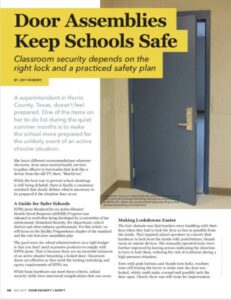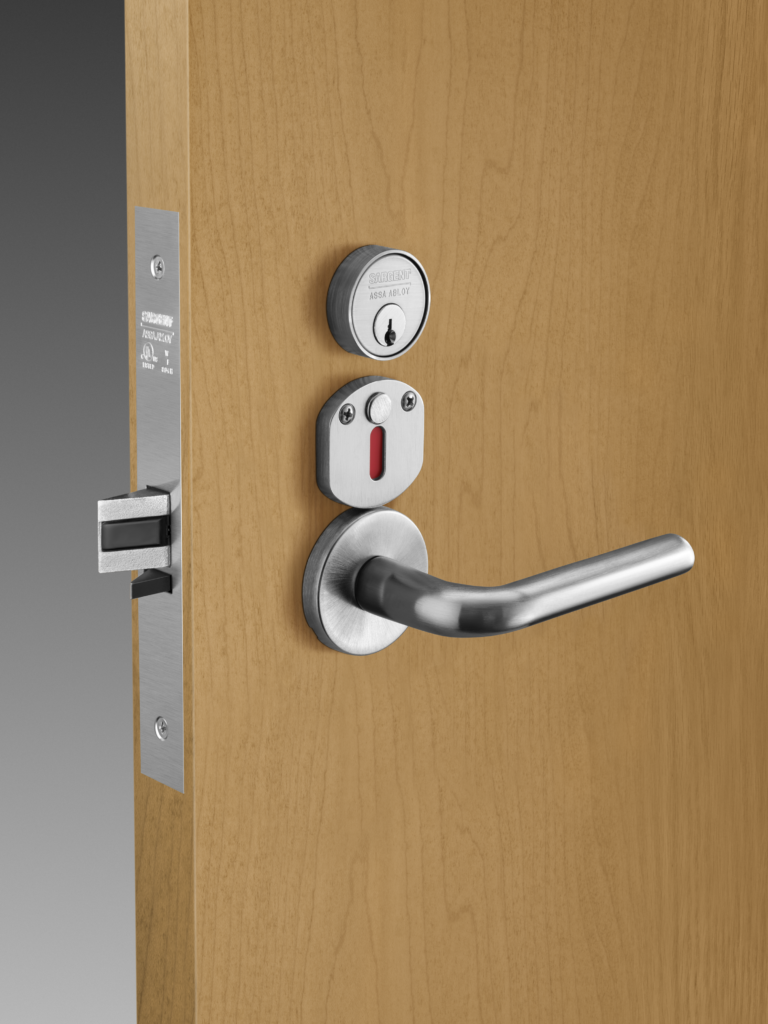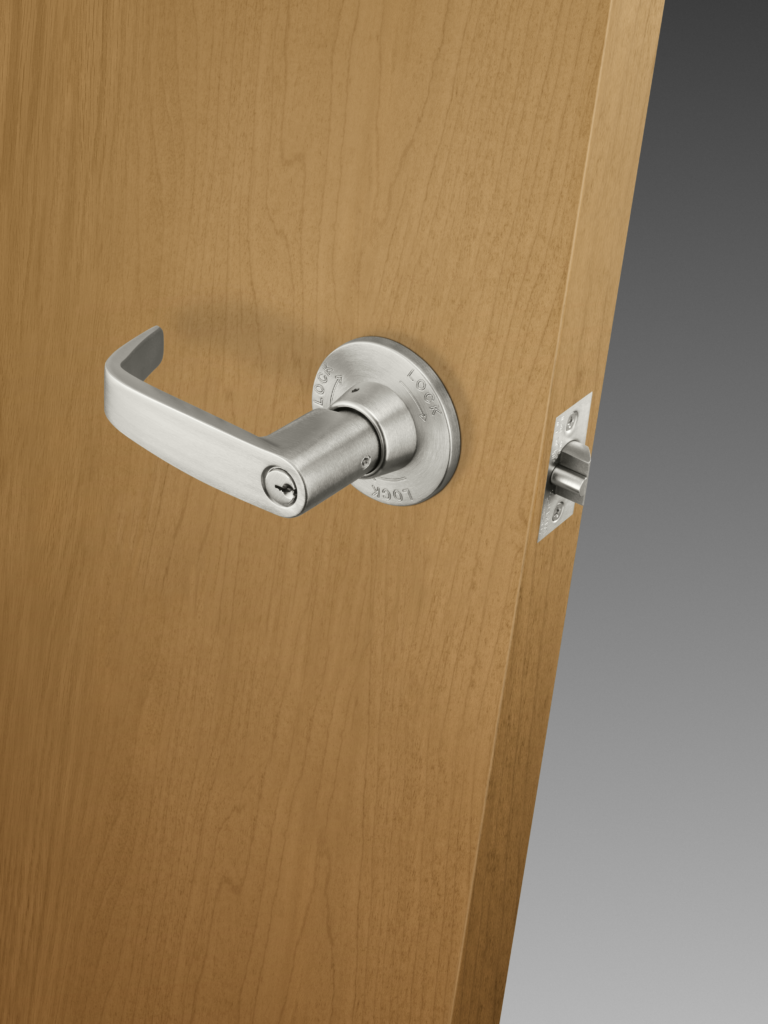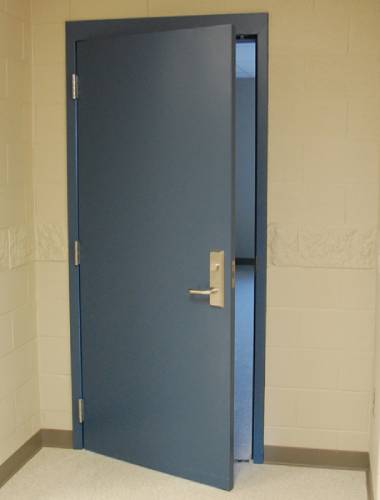Door Assemblies Keep Schools Safe
Whatever custom steel doors you choose, consult with the manufacturer early in the process—they’ve seen it all and can be very helpful in the design process.

A superintendent in Harris County, Texas doesn’t feel prepared. One of her to-do’s during the quiet summer months is to make the school more prepared for the unlikely event of an active shooter situation.
She hears different recommendations wherever she turns, from more mental health services to police officers to barricades that look like a device from the old TV show MacGyver.
While the best way to prevent school shootings is still being debated, there is finally a consensus standard that clearly defines what is necessary to be prepared if the situation does occur — and door barricades for schools are not the answer.
A Guide for Safer Schools
NFPA 3000 Standard for an Active Shooter/Hostile Event Response Program was published in 2018 by a committee of law enforcement, Homeland Security, fire departments, school districts, and other industry professionals. For this article, we will focus on the Facility Preparedness chapter of the standard and the role that door assemblies play.
The good news for school administrators on a tight budget is that you don’t need expensive products to be in compliance with NFPA 3000. Why? Because there are zero recorded instances of an active shooter breaching a locked door. Classroom doors are in good shape as long as they meet the locking/unlocking and egress requirements of NFPA 101.
While basic hardware can meet these criteria, school security drills have uncovered a couple hang-ups that can occur.
Making Lockdowns Easier
The first is that teachers were fumbling their keys when they had to lock the door as fast as possible from the inside. That inspired school operators to convert their hardware to lock from the inside with push buttons, thumb turns or remote devices. The manually operated locks were further improved by having arrows indicating the direction to turn to lock them, reducing the risk of confusion during a high-pressure situation.

Lockdown is made as easy as possible with hardware such as this that uses color to clearly display if the door is locked or unlocked

Manually operated locks were further improved by having arrows indicating the direction to turn to lock them, reducing the risk of confusion during a high-pressure situation
Even with push buttons and thumb turn locks, teachers were still testing the levers to make sure the door was locked, which could make a sound and possibly inch the door open. There was clearly still room for improvement.
Dave Higginson has been with Sargent Manufacturing and Corbin Russwin for 26 years and has seen firsthand how hardware has evolved to improve school security.
“A lot of schools are going beyond basic compliance and selecting hardware that makes their lockdown as easy as possible. They’re buying hardware with large indicators on the inside that display if the door is locked or unlocked. They have bright, reflective backing that is visible from 180 degrees so it can be viewed from a crouching position. That allows occupants to follow the protocol of locking the door, turning off the lights, and staying out of sight [or closing the blinds, if they have them].”
Most hardware manufacturers offer retrofit kits that make it easy to swap in new hardware with the reflective lock indicator.
Secure the Perimeter
In addition to classrooms, school security plans also have a strong emphasis on controlling who can step foot on campus. This may include fencing and only a few entry points, each of which are monitored by personnel and/or electronically.
Tough as Steel
 Hollow metal doors are well-suited for retrofits and can be adapted for hardware with indicators, electric hardware, and/or vision lights. They also shine in school environments where beating up doors is a common extracurricular activity. In fact, an extra heavy duty door from an SDI Certified manufacturer is tested to withstand one million open and close cycles with latching.
Hollow metal doors are well-suited for retrofits and can be adapted for hardware with indicators, electric hardware, and/or vision lights. They also shine in school environments where beating up doors is a common extracurricular activity. In fact, an extra heavy duty door from an SDI Certified manufacturer is tested to withstand one million open and close cycles with latching.
Steel is naturally very strong, so there’s no need to go overboard. Door gauges (ie. their level of performance) should be based on the use of the opening. While an extra heavy duty 16 gauge door makes sense for the school entrance, it would be overkill for the broom closet door. You can see the most common gauges and door designs for the various openings at a school by using the manufacturer-neutral Door Selector tool at SteelDoor.org.
A Goal without a Plan is Just a Wish
Having great door assemblies doesn’t mean much if the faculty doesn’t have a gameplan for an active threat situation. Is there an alarm? Does it sound different than the fire alarm? Should teachers look in the hallway for nearby students before locking down their rooms? Then what?
NFPA 3000 compliance requires school operators to have a plan and practice it annually.
Superintendents are faced with an overwhelming amount of passionate, well-intentioned suggestions to make their schools safer. We encourage you to advise them that as long as they have a plan, and door assemblies that meet basic life safety requirements, they’ll be off to a great start.
This handy list from lockdontblock.org makes it easy to determine if classroom locks are code compliant.
Location
Door hardware operable parts should be located between 34 and 38 inches above the floor, and not require special knowledge or effort, nor key or tool, nor require tight grasping, twisting, or pinching to operate, and accomplished with one operation.
Security
Be easily lockable in case of emergency from within the classroom without opening the door.
Lockable
Lockable and unlockable from outside the door.
